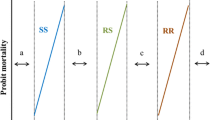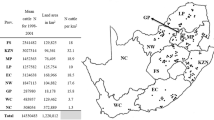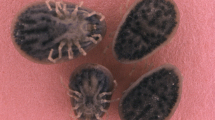Abstract
In many countries in eastern, centrai and southern Africa, twice-weekly to two-weekly acaricide applications are practised to prevent mortality of exotic cattle from tick-borne diseases. This practice has been extended to areas where only local cattle are present. These measures are very costly, inefficient in controlling diseases and ecologically undesirable.
In view of the many difficulties with the present method of tick control, exploitation of tick-resistant cattle breeds in enzootically stable situations would appear to be a pragmatic, alternative approach to the intensive use of acaricides. This paper reviews studies on host-tick relationships in Africa with a view to understand the role of naturally acquired resistance in limiting tick populations and hence its use in integrated pest management strategies. The levels of information required are outlined such as identification and quantification of resistance, effect of cattle breeds and productivity and economics in relation to host-resistance.
Résumé
Dans beaucoup de pays d’Afrique de l’est, centrale et australe, des applications d’acaricides bi-hebdomadaires à bi-mensuelles ont été pratiquées à l’origine pour protéger les bovins exotiques des maladies à tiques. Par la suite, ces mesures ont été étendues à des zones ou seuls les bovins indigènes étaient présents. Ces pratiques se sont alors révélées très coûteuses, insuffisantes pour contrôler ces pathologies et écologiquement pénalisantes.
En regard des nombreuses difficultés rencontrées dans la mise en application de ces méthodes de contrôle, l’utilisation de races bovines résistantes dans un environnement enzootiquement stable apparait comme la meilleure alternative à l’utilisation intensive des acaricides. Cet article passe en revue les relations hôtes-parasites en Afrique et plus particulièrement, le rôle de l’immunité naturelle acquise de l’hôte dans la limitation des populations de tiques et son utilisation dans les programmes de lutte intégrés. Les points suivants ont été particulièrement développés: identification et quantification de la résistance de l’hôte, relation entre la race, la productivité, les performances économiques et le niveau de résistance.
Similar content being viewed by others
References
Binta M.G. and Cunningham M.P. (1984) Cutaneous responses of cattle to extracts from Rhipicephalus appendiculatus larvae. Vet. Parasitol. 15, 67–73.
Bonsma J. C. (1981) Breeding tick-repellent cattle. In Tick Biology and Control (Edited by Whitehead G. B. and Gibson J. D.), pp. 67–77. Tick Research Unit, Rhodes University, Grahamstown, South Africa.
Bourne A. S., Sutherst R. W., Sutherland I. D., Maywald G. F. and Stegeman D. A. (1988) Ecology of the cattle tick (Boophilus microplus) in subtropical Australia. III Modelling populations on different breeds of cattle. Aust. J. Agric. Res. 39, 309–318.
Capstick P. B., de Castro J. J., Nokoe S. and Nyindo M. N. (1987) Correlation of host resistance with intradermal response, pp. 43. Fifteenth Annual Report. The International Centre of Insect Physiology and Ecology, Nairobi, Kenya.
Chiera J. W., Newson R. M. and Cunningham M. P. (1985a) Cumulative effects of host resistance on Rhipicephalus appendiculatus Neumann (Acarina: Ixodidae) in the laboratory. Parasitology 90, 401–408.
Chiera J. W., Newson R. M. and Cunningham M. P. (1985b) The effect of size on feeding and breeding performance of Rhipicephalus appendiculatus Neumann. Insect Sci. Applic. 6, 555–560.
Cunningham M. P. (1981) Biological control of ticks with particular reference to Rhipicephalus appendiculatus. In Advances in the Control of Theileriosis (Edited by Irvin A. D., Cunningham M. P. and Young A. S.), pp. 160–164. Martinus Nijhoff Publishers, The Hague, Boston, London.
de Castro J. J., Cunningham M. P., Dolan T. T., Dransfield R. D., Newson R. M. and Young A.S. (1985a) Effects on cattle of artificial infestations with the tick Rhipicephalus appendiculatus. Parasitology 90, 21–33.
de Castro J. J., Young A. S., Dransfield R. D., Cunningham M. P. and Dolan T. T. (1985b) Effects of infestation on Boran (Bos indicus) cattle immunized against theileriosis in an endemic area of Kenya. Res. Vet. Sci. 39, 279–288.
de Castro J.J., Newson R.M. and Herbert I.V. (1989) Resistance in cattle against Rhipicephalus appendiculatus with an assessment of cross-resistance to R. pulchellus (Acari: Ixodidae). Exp. Appl. Acarol. 6, 237–244.
Dolan R. B. (1986) The principles of selection for tick resistance. The Kenya Veterinarian 10, 34–35.
Dolan R. B. (1987) Genetics and trypanotolerance. Parasitology Today 3, 127–143.
Fivaz B. H. and Norval A. (1989) Observations on successive infestations of the rabbit host by the ticks Rhipicephalus appendiculatus and R. zambeziensis (Acari: Ixodidae). Exp. Appl. Acarol. 7, 267–279.
Fivaz B. H., Norval A. R. I. and Lawrence J. A. (1989) Transmission of Theileria parva bovis (Boleni strain) to cattle resistant to the brown ear tick Rhipicephalus appendiculatus (Neumann). Trop. Anim. Hlth. Prod. 21, 129–134.
Francis J. (1966) Resistance of zebu and other cattle to tick infestation and babesiosis with special reference to Australia: An historical review. Br. Vet. J. 122, 301–307.
Jongejan F., Pegram R. G., Zivkovic D., Hensen E. J., Mwase E. T., Thielemans M. J. C., Cosse A., Niewold T. A., Ashraf El Asaid and Uilenberg G. (1989) Monitoring of naturally acquired and artificially induced immunity to Amblyomma variegatum and Rhipicephalus appendiculatus ticks under field and laboratory conditions. Exp. Appl. Acarol. 7, 181–199.
Jongejan F., Zivkovic D., Pegram R. G., Tatchell R. J., Fison T., Latif A. A. and Paine G. (1987) Ticks (Acari: Ixodidae) of the Blue and White Nile ecosystems in the Sudan with particular reference to the Rhipicephalussanguineus group. Exp. Appl. Acarol. 3, 331–346.
Kaiser M. N., Sutherst R. W. and Bourne A. S. (1982) Relationship between ticks and zebu cattle in southern Uganda. Trop. Anim. Hlth. Prod. 14, 63–74.
Kaiser M. N., SutherstR. W., Bourne A. S., Gorrisen L. and Floyd R. B. (1988) Population dynamics of ticks on Ankole cattle in five ecological zones in Burundi and strategies for their control. Prev. Vet. Med. 6, 199–222.
Latif A. A. (1984a) Resistance to natural tick infestations in different breeds of cattle in the Sudan. Insect Sci. Applic. 5, 95–97.
Latif A. A. (1984b) Resistance to Hyalomma anatolicum anatolicum Koch (1844) and Rhipicephalus evertsi Neumann (1987) (Acarina: Ixodidae) by cattle in the Sudan. Insect Sci. Applic. 5, 509–511.
Latif A. A., Newson R. M. and Dhadialla T. S. (1988) Feeding performance of Amblyomma variegatum (Acarina: Ixodidae) fed repeatedly on rabbits. Exp. Appl. Acarol. 5, 83–92.
Latif A. A., Nokoe S., Punyua D. K. and Capstick P. B. (1991a) Tick infestations on zebu cattle in Western Kenya: Quantitative assessment of host resistance. J. Med. Entomol. 28, 122–126.
Latif A. A., Punyua D. K., Nokoe S. and Capstick P. B. (1991b) Tick infestations on zebu cattle in Western Kenya: Individual host variation. J. Med. Entomol. 28, 114–121.
Latif A. A., Punyua D. K., Capstick P. B. and Newson R. M. (1991c) Tick infestations on zebu cattle in Western Kenya: Hostresistance to Rhipicephalus appendiculatus (Acari: Ixodidae). J. Med Entomol. 28, 127–132.
Latif A. A., Punyua D. K., Capstick P. B., Nokoe S., Walker A. R. and Fletcher J. D. (1991d) Histopathology of attachment sites of Amblyomma variegatum and Rhipicephalus appendicular on zebu cattle of varying resistance to ticks. Vet. Parasitol. 38, 205–213.
Luguru S. M., Banda D. S. and Pegram R. G. (1984) Susceptibility of ticks to acaricides in Zambia. Trop. Anim. Hlth. Prod. 16, 21–26.
McCosker P. J. (1979) Global aspects of the management and control of ticks of veterinary importance. Recent Advances in Acarology 11. Academic Press, New York. pp. 45–53.
Muriithi I. E. (1984) Delivery of services: the case for tick control. In Advancing Agricultural Production in Africa (Edited by Hawksworth D. L.), pp. 266–268. Commonwealth Agricultural Bureaux, UK.
Mwangi E. N., Rinkanya F. G. R., Ongare J. O. and Malonza M. M. (1983) Pattern of engorgement and estimation of the number of Rhipicephalus appendicular female ticks which complete engorgement on the host. Kenya Vet. 7, 13–16.
Newson R. M., Mela P. N. P. and Franklin T. E. (1973) Observations on the numbers of the tick Rhipicephalus appendicular on the ears of zebu cattle in relation to hierarchical status in the herd. Trop. Anim. Hlth. Prod. 5, 281–283.
Nokoe S. and Rogo L. M. (1988) A discriminant function for the short- and long-setaed forms of the Mononychellus (Acari: Tetranchidae) species complex. Insect Sci. Applic. 9, 429–432.
Norval R. A. I. (1982) A re-assessment of the role of dipping in the control of tick-bome disease in Zimbabwe. In Tick Biology and Control (Edited by Whitehead G. B. and Gibson J. D.), pp. 87–90. Tick Research Unit, Rhodes University Grahamstown, South Africa.
Norval R. A. I. (1983) Arguments against intensive dipping. Zimbabwe Vet. J. 14, 19–25.
Norval R. A. I., Butler J. F. and Yunker C. E. (1989a) Use of carbon dioxide and natural or synthetic aggregation-attachment pheromone of the bont tick, Amblyomma hebraeum, to attract and trap unfed adults in the field. Exp. Appl. Acarol. 7, 171–180.
Norval R. A. I., Sutherst R. W., Jorgensen O. G., Gibson J. D. and Kerr J. D. (1989b) The effect of the bont tick (Amblyomma hebraeum) on the weight gain of Africander steers. Vet. Parasitol. 33, 329–341.
Norval R. A. I., Sutherst R. W., Kurki J., Gibson J. D. and Kerr J. D. (1988) The effect of the brown ear-tick Rhipicephalus appendicular on the growth of Sanga and European breed cattle. Vet. Parasitol. 30, 149–164.
Norton G. A. (1987) A strategic research approach for tick control programmes. In Ticks and Tick-borne Diseases (Edited by Sutherst R.W.), pp. 126–132. Australian Centre for International Agricultural Research. Canberra. ACIAR Proceedings No. 17.
Nyindo M., Essuman S. and Dhadialla T. S. (1989) Immunization against ticks: use of salivary gland antigens and infestations with Rhipicephalus appendicular (Acari: Ixodidae) in rabbits. J. Med. Entomol. 26, 430–434.
Pegram R. G. and Lemche J. (1985) Observations on the efficacy of ivermectin in the control of cattle ticks in Zambia. Vet. Rec. 117, 551–554.
Pegram R. G., Lemche J., Chizyuka H. G. B., Sutherst R. W., Floyd R. B., Kerr J. D. and McCosker P. J. (1989a) Effect of tick control on liveweight gain of cattle in central Zambia. Med. Vet. Entomol. 3, 313–320.
Pegram R. G., Lemche J., Chizyuka H. G. B., Sutherst R. W., Floyd R. B., Kerr J. D. and McCosker P. J. (1989b) Ecological aspects of cattle tick control in Central Zambia. Med. Vet. Entomol. 3, 307–312.
Pegram R. G. and Chizyuka H. G. B. (1990) The impact of natural infestations of ticks in Zambia on the productivity of cattle and implications for tick control strategies in Central Africa. Parassitologia (in press).
Rechav Y. (1987) Resistance of Brahman and Hereford cattle to African ticks with reference to serum gamma globulin levels and blood composition. Exp. Appl. Acarol. 3, 219–232.
Rechav Y., Dauth J. and Els D. A. (1990) Resistance of Brahman and Simmentaler cattle to Southern African ticks. Onderstepoort J. Vet. Res. 57, 7–12.
Rechav Y., Heller-Haupt A. and Varma M. G. R. (1989) Resistance and cross-resistance in guineapigs and rabbits to immature stages of ixodid ticks. Med. Vet. Entomol. 3, 333–336.
Rechav Y. and Zeederberg M. E. (1986) Tick populations on two breeds of cattle under field conditions, with a note on blood components related to host resistance. In Morphology, Physiology and Behaviourial Biology of Ticks (Edited by Sauer J. R. and Hair J. A.), pp. 445–456. Ellis Horwood, Chichester.
Sere C. (1979) Towards an economic assessment of veterinary inputs in tropical Africa. ILCA Working Document No. 1, p. 63.
Smith R. E., Mwase E. T., Heller-Haupt A., Trinder P. K. E., Pegram R. G., Wilsmore A. J. and Varma M. G. R. (1989) Delayed-type hypersensitivity test for assessing tick-immune status of cattle in Zambia. Vet. Rec. 124, 538–584.
Stear M. J., Neumann M. J., Nicholas F. W., Brown S. C. and Holroyd R. G. (1984) Tick resistance and the major histocompatibility system. Aust. J. Exp. Med. Sci. 62, 47–52.
Sutherst R. W. (1987) Modelling tick populations. 4. Parasitic phase. In Ticks and Tick-borne Diseases (Edited by Sutherst R. W.), pp. 54–57. ACIAR, Canberra. ACIAR Proceedings No. 17.
Sutherst R. W., Kerr J. D., Maywald G. F. and Stegeman D. F. (1983) The effect of season and nutrition on the resistance of cattle to the tick Boophilusmicroplus. Aust. J. Agric. Res. 34, 329–339.
Sutherst R. W., Roberts J. A. and Wagland B. M. (1979a) Resistance in cattle to Haemaphysalis (Kaiseriana) longicornis. Int. J. Parasitol. 9, 183–188.
Sutherst R. W., Wharton R. H., Sutherland I. D. and Bourne A. S. (1979b) Long-term population studies on the cattle tick (Boophilus microplus) on untreated cattle selected for different levels of tick resistance. Aust. J. Agric. Res. 30, 353–368.
Sutherst R. W., Wharton R. H. and Utech K. B. W. (1978) Guide to studies on tick ecology. Technical Paper No. 14. CSIRO Division of Entomology, Canberra.
Tatchell R. J. (1981) Current methods of tick control with special reference to theileriosis. In Advances in the Control of Theileriosis (Edited by Irvin A. D., Cunningham M. P. and Young A. S.), pp. 148–159. Martinus Nijhoff Publishers, The Hague, Boston, London.
Tatchell R. J. (1984) The case for tick control. In Advancing Agricultural Production in Africa (Edited by Hawksworth D. L.), pp. 268–269. Commonwealth Agricultural Bureaux, UK.
Tatchell R. J. (1986) Interactions between ticks and their hosts. In Proc 6th Int. Congr. Parasitol., Australia, Brisbane, 1986 (Edited by Howell J. M.), pp. 597–606. Australian National University, Canberra.
Tatchell R. J. (1988) A study of the effect of tick infestation on liveweight gain of cattle in the Sudan. Trop. Pest Manage. 34, 165–167.
Tatchell R. J., Chimwani D., Chirchir S. J., Ongare J. O., Mwangi E., Rinkanya F. and Whittington D. (1986) A study of the justification for intensive tick control in Kenyan rangelands. Vet. Rec. 119, 401–403.
Tatchell R. J. and Easton E. (1986) Tick (Acari: Ixodidae) ecological studies in Tanzania. Bull. Entomol. Res. 76, 229–246.
Trail J. C. M. and Gregory K. E. (1981) Characterization of the Boran and Sahiwal breeds of cattle for economic characters. J. Anim. Sci. 52, 1286–1293.
Utech K. B. W., Wharton R. H. and Kerr J. D. (1978) Resistance to Boophilus microplus (Canestrini) in different breeds of cattle. Aust. J..Agric. Res. 29, 885–895.
Young A. S., Groocock C. M. and Kariuki D. P. (1988) Integrated control of ticks and tick-borne diseases of cattle in Africa. Parasitology 96, 403–432.
Walker A. R. and Fletcher J. D. (1990) Skin test to detect resistance of cattle to Rhipicephalus appendicular ticks. Med. Vet. Entomol. 4, 321–325.
Walker A. R., Fletcher J. D. and Todd L. (1991) Resistance between stages of the tick Rhipicephalus appendiculatus (Acari: Ixodidae). J. Med. Entomol. 27, 955–961.
Willadsen P. G. W., Roberts J. A. and Kerr J. D. (1978) Responses of cattle to allergens from Boophilus microplus. Int. J. Parasitol. 8, 89–95.
Author information
Authors and Affiliations
Rights and permissions
About this article
Cite this article
Latif, A.A., Pegram, R.G. Naturally Acquired Host Resistance in Tick Control in Africa. Int J Trop Insect Sci 13, 505–513 (1992). https://doi.org/10.1017/S1742758400016088
Received:
Revised:
Published:
Issue Date:
DOI: https://doi.org/10.1017/S1742758400016088




